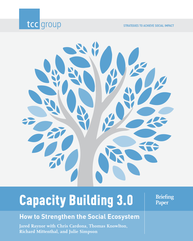Resources
Here are some resources and publications that:
Welcome aboard . . .
- target different audiences,
- give your a broad introduction to how networks impact various sectors,
- introduce you to a range of tools and ideas that you can use to navigate the emerging world of networks, and
- provide you with some inspiration for our work.
Welcome aboard . . .
Videos
|
|
The Ellen MacArthur Foundation is dedicated to accelerating the transition to a circular economy. Many people are beginning to become curious about what is a circular economy. This great explainer video visually shows "What is a circular economy?"
|
|
|
Trebor Scholz, Associate Professor for Culture & Media at The New School in New York City, explains the basic tenets of platform cooperativism and why it's an essential strategy for moving towards a more equitable economic model based on cooperative ownership. The title of this presentation is "How platform cooperativism can unleash the network."
|
|
|
Don Tapscott explains how blockchain is changing the nature of reality from asset management, to music, to emerging businesses that are without intermediaries. This talk, called "How the blockchain is changing money and business," also addresses the Internet of Value, cryptocurrency, and blockchain as it relates to security.
|
|
|
This video is entitled "The unstoppable rise of the collaborative economy," which is from a presentation by Shane Hughes at TEDxLausanne. The video presents an alternative vision of our economic model based on collaboration, which is already emerging and is rooted in networks. Topics include cooperatives, the information economy, disruption, and examples of community based economics.
|
Publications

A Network Approach to Capacity Building draws on examples from across the Council on Foundations network of state associations of nonprofits and CoF staff's direct experience to make the case for intentionally using networks to build nonprofit capacity and expand impact. Written by Jennifer Chandler and Kristen Scott Kennedy, this resource provides strategies, practices, and case studies on how to use networks to accelerate capacity building.

Capacity Building 3.0 How to Strengthen the Social Ecosystem This paper is organized in the following way: The first section, “ A Basic Distinction,” covers fundamental concepts, terms, and definitions of capacity and capacity building critical to our discussion. The second section, entitled “An Evolution in the Who,” examines who needs to build capacity and how that understanding has evolved over time. The third section, entitled “An Evolution in the What,” assesses how capacity in capacity-building has evolved, arriving at a new “organizational actualization” framework. The fourth section, “An Evolution in the How,” highlights the emergence of new methods for accomplishing capacity building and details the new innovations and techniques that are being used by those doing effective capacity building.

Catalyzing Networks For Social Change is a guide for funders to understand the emerging world of networks, written by Diana Scearce, and published by the Monitor Institute and Grantmaker's for Effective Organizations. The report is a guide for grantmakers who are just beginning to explore and experiment with networks and for those who are further along and want to reflect on their practice.

This essay, written by Diana Scearce and published by the Monitor Institute in partnership with the Knight Foundation, examines how funders can help individuals make a positive difference in their communities and the world amid increasing levels of interdependence, decentralization and transparency. The report looks at:
1) Leading-edge practices for promoting community engagement and quality information in this networked context. 2) What the world might look like for connected citizens. 3) Three potential future scenarios with considerations and implications for those who want to support strong communities and a healthy democracy. 4) Near-term recommendations for grantmakers who want to channel their resources and leadership toward harnessing the power of networks for civic engagement.
1) Leading-edge practices for promoting community engagement and quality information in this networked context. 2) What the world might look like for connected citizens. 3) Three potential future scenarios with considerations and implications for those who want to support strong communities and a healthy democracy. 4) Near-term recommendations for grantmakers who want to channel their resources and leadership toward harnessing the power of networks for civic engagement.

This 2010 case study highlights the work of a regional network, RE-AMP Energy Network, which is comprised of 125 nonprofit organizations and funders across eight states in the upper Midwest. The network focuses on reducing regional and global warming emissions by 80 percent (of the 2005 levels) by 2050. The case study highlights: 1) The six key principles that RE-AMP members followed in building their network, 2) The organizational structure and strategy of the network, and 3) The wide array of outcomes that resulted in using a network approach for approaching this important issue. This case study is published by the Monitor Institute, and was written by Heather McLeod Grant and Noah Flower.
Websites and articles
Funding the Ocean - http://fundingtheocean.org
Healthy Food Access Portal - http://healthyfoodaccess.org
Plus Acumen (The World's School for Social Change) - http://www.plusacumen.org
Nonprofit Quarterly, The Fluid Roles of Networks in Social Movements
June Holley's Network Weaver - www.networkweaver.com
Grantmakers for Effective Organizations - http://www.geofunders.org
Healthy Food Access Portal - http://healthyfoodaccess.org
Plus Acumen (The World's School for Social Change) - http://www.plusacumen.org
Nonprofit Quarterly, The Fluid Roles of Networks in Social Movements
June Holley's Network Weaver - www.networkweaver.com
Grantmakers for Effective Organizations - http://www.geofunders.org
Network Weaver:
|


